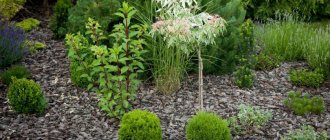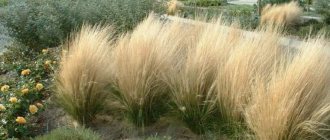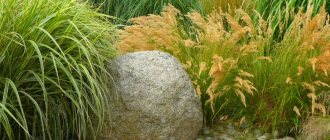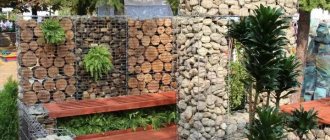Moss is an amazing plant found even in Antarctica. The Japanese were the first to master artificial breeding of ornamental species in the 6th century. Only relatively recently did emerald carpets begin to decorate gardens and lawns all over the world.
A landscape pattern may consist of one or more bryophytes, differing in shade and texture. The green covering harmonizes well with shade-tolerant “neighbors” - ferns, ground cover crops, hostas, saxifrages.
Short description
There are more than 200 thousand bryophytes in nature. Technically, they are classified as bryophytes - plants without a root system. How then do they grow? With the help of rhizoids located below - thin, thread-like processes.
Otherwise, everything is the same as everyone else - in the photo of decorative moss you can see the stems and small leaves. Mosses grow in colonies in damp, shaded places, covering the ground with a soft edge.
Plant lifespan
Decorative moss is the prerogative of eco-style lovers. Landscaping your property or home improves your well-being and improves your mood. With proper care, living decor retains its attractive appearance for up to 10 years. If not properly cared for, moss rarely grows for more than 2-3 years. The main three factors affecting the lifespan of bryophytes are moisture, lack of sunlight and temperatures above +4 degrees. If these conditions are met, moss grows for as long as possible.
Application
In landscape design, the popularity of evergreen perennials is explained by the unique properties of moss. Let's list just some of them:
Practicality. This is an unpretentious plant, not demanding on soil composition, fertilizers and light conditions. It is grown where other greens will not take root. Many designers choose moss because it is difficult for weeds to penetrate through its dense cushion.
Vitality. Any type of bryophyte easily takes root on stone. Therefore, a common technique is to create mossy sculptures, fountains, borders, and waterfalls. With their help, they create an atmosphere of antiquity and emphasize the pristine beauty of nature.
Aesthetics. For landscaping, you can use specimens with simple or openwork leaves, create multi-colored lawn compositions and alpine slides. Light and dark moss, planted in a checkerboard pattern, looks interesting.
Decorative moss - how to care for it correctly
Moss is an unpretentious plant. Despite this, he also needs care. In order for the bryophyte to please with its rich green color and attractive appearance, you should create comfortable conditions for it, especially when it comes to seedlings.
The main condition for comfortable growth of moss is regular soil moisture, especially in the first few days after planting.
Preparation of material
The creation of a decorative moss cover begins with the collection of materials. You can purchase ready-made seedlings in the store or prepare them yourself. In both cases, follow a few rules:
- Choose mature specimens - this way there is a better chance that they will survive transportation and planting well.
- Handle the moss carefully - do not damage the root shoots. If the plant is collected in the forest, it is slightly dug up and taken out of the ground.
- For various purposes, your own moss is preferable. To improve lawns, look for ground cover species, and to decorate trees, look for those that grow on trunks.
Differences in caring for decorative moss in an apartment and an office
When planting moss in the office, it is necessary to regularly use moisturizers. In an apartment or house, the humidity level is always higher due to the high level of evaporation during cooking, as well as the use of water pipes.
There are no factors that increase dampness in the office. Therefore, it is necessary to artificially increase the humidity so that the living ornamental plant grows without problems. With insufficient moisture, moss becomes hard, dull and lethargic.
Special humidifiers or a regular bowl of water, which should be placed near the plant, will help to humidify the air in the office.
It is recommended to place living decor away from heating radiators and air conditioners, which dry out the air.
Dust should be removed from the plant once a month. Cold air is ideal for this.
It is not recommended to touch the plant with your hands, as the moss is afraid of tactile contact. When touched, it is easy to damage the top of the plant and ruin its attractive appearance.
Selecting a location
Vertical and horizontal zones are equally suitable as a landing bridge. The main thing is that the surface structure is porous and rough. By preparing a special composition, you can turn ordinary moss on the wall into graffiti:
Mix in a blender a couple of pieces of washed moss, 1/3 cup of low-fat kefir, 1 tsp. granulated sugar, and 2-3 tbsp. hydrogel for flowers. Bring the mixture to a thick paste.
Using a stencil or a simple pencil, mark the outline of the figure. We collect the composition with a brush and apply it to the brickwork or concrete. The thicker the layer of paste, the thicker the edge will be.
Bryophytes grow best on western and northern sides. Although direct sunlight is detrimental to sprouts, a small portion of the morning sun will be beneficial - the color of the mossy pillow will become more saturated.
Useful properties of Icelandic Cetraria
Cetraria, which even an inexperienced gardener can grow at home, contains B vitamins, organic acids, copper, gum, iron, manganese, polysaccharides and other useful substances.
And it is known that the plant has the following effects on the body:
- increases immunity;
- accelerates tissue regeneration;
- prevents the development of tumors;
- normalizes appetite and stomach function;
Icelandic cetraria improves the functioning of the stomach and the entire gastrointestinal tract
- has a calming effect on the nervous system;
- fights pathogenic flora (fungi, viruses, microbes);
- increases blood clotting.
Disembarkation
Flower growers believe that the optimal time for planting moss is autumn. Plants to be planted are pre-bathed in a container of water.
Rooting is carried out in the following order:
- Clear the area of leaves, debris, and grass. The soil is loosened and depressions of 2-4 cm are formed.
- A substrate of peat, forest soil, and black soil is placed in the holes. After that, moss turf is placed there, pressing slightly.
- For growth, a necessary condition is an interval of at least 25 cm between neighboring moss bushes.
- After planting, the moss is thoroughly irrigated. As it dries, watering is repeated.
- An ideal pair for mossy islands would be oxalis, lichens, conifers, and berries (lingonberries, strawberries).
Where can I get decorative moss?
Do you dream of creating an interesting composition of moss in the interior or on the site? Start from scratch. Do not forget that the plant loves shady places and a clean, unpolluted atmosphere. Before planting, you should clear the land and remove weeds.
Moss is a plant that reproduces by spores. There are two ways to grow it in the garden:
- using special seedlings;
- create the conditions for its emergence.
It may take a long time for a moss layer to appear on an area on its own. This is why most gardeners choose seedlings. It can be purchased at a specialty store or nursery or gardening nursery.
Want to save money? Collect moss with your own hands from the nearest forest or move it from other areas to a new place.
To do this, you should dig up the moss plates with part of the soil. This is necessary for the plant to quickly adapt to its new location. Initially, the moss pads are moistened with water, after which they are planted at a distance of 20-25 cm from each other and pressed to the ground.
Basic rules for assembling moss:
- moss should be collected on stones, stumps and tree trunks;
- It is necessary to pinch off the plant in small bunches so as not to disturb the natural balance;
- after collection, the moss should be cleaned of foreign debris - dry leaves, twigs, by lightly shaking the bunches;
- It is preferable to collect the plant in a box or thick bag, which will ensure safe transportation to the planting site.
Moss is easy to spot in a coniferous forest. This is due to the fact that the branches of coniferous trees create the necessary partial shade and humidity, which is necessary for germination. You should also pay attention to swampy areas.
Want to plant moss on uneven or vertical surfaces? Do not forget to secure the plant with wood chips or tree bark so that the pads do not slide down during rain.
Different types of moss are compatible with each other, so you can be creative and mix bryophytes with each other.
After transplantation and proper moisture, the moss will begin to add new growth points and gradually grow throughout the area.
By slowly decorating the garden, you can create conditions in which moss will appear on the site on its own. To do this, you need to dig up the area that is planned for landscaping with moss. Afterwards, add herbicides and peat to the top layer of soil. The first results of labor can be seen no earlier than in 2 years. Thick moss will appear after another 3-4 years on the area treated with fertilizers. During this entire time, the soil must be moistened abundantly.
For the secrets of harvesting moss, watch our video:
Types of moss for garden design
Despite the fact that there are thousands of varieties of moss, only a small part is used to decorate the garden. The most common among them:
Leucobrium. It is distinguished by its bluish, light green color and velvety turf. Does well in the shade, but can survive in the sun. Occasionally you can find yellow or brown juniper leucobrium.
Subulate phlox. Strictly speaking, this perennial is not a bryophyte, but due to its short stature and density it resembles flowering moss.
- How to choose a drilling company: top 5 tips from experts
Cleaning the beds
Buy bonsai
It is not surprising that its second name is moss carnation. The birthplace of the flower is North America. It was from there that this low-growing plant of pink, lilac, white, and purple colors moved to our region.
Kukushkin flax (Polytrichum). A compact, elongated columnar plant up to 40 cm high. Prefers marshy, acidified soil and shade.
Decorative moss - main varieties
Moss is popular not only among designers, but also among lovers of phytointeriors. Its presence allows you to add bright colors and freshness, making the atmosphere more comfortable. Looking at a wall of green moss, a person’s eyes rest and relax as much as possible. Moss can be used not only in apartments and houses, but also in offices and public places.
Depending on the location, decorative moss can be of the following types:
- On the wall. When decorating vertical surfaces, flat, spongy or hummock-shaped moss is used.
Flat looks like a soft carpet made of natural material. Hummock-shaped is used to create three-dimensional paintings in both residential and business premises. Spongy moss is particularly soft and can act as decoration not only for walls, but also for other surfaces. - For garden. Decoration with moss in open areas can be done with the following types of plants:
- dicranum. Small soft pads of bright green color, several centimeters high. Most often used when decorating vertical surfaces in the garden;
- Leucobria. Ideal for planting in sandy soil or damp areas that rarely receive sunlight;
- hypnotic. Used when decorating the surfaces of natural stone or concrete;
- cuckoo flax Reminiscent of vertical columns stretched upward. Suitable for decorating Japanese gardens;
- fern moss. Used to create thickets and has beautiful carved leaves;
- sphagnum. It is used for outdoor and indoor floriculture at the same time.
- For the interior. Designers actively use decorative moss when decorating modern interiors. Most often, it is used to decorate walls, interior items and furniture.
In recent years, so-called phytowalls , which resemble a piece of a garden or forest right in the middle of a living space, have become especially popular.
In addition to their aesthetic function, bryophytes purify indoor air and control the level of air humidity, which is especially important in conditions of high humidity, poor ecology and air pollution in large cities.
Blooming decorative moss deserves special attention. In addition to beautiful dense greenery, it pleases the eye with bright blooms. The flowering plant can be used in landscape design, as well as in interior design.
What does it look like in the interior of the rooms?
Moss is popular in different rooms, but in each it has its own tasks.
Kitchen
Moss in the kitchen interior is a beautiful accent that allows you to highlight the dining area or decorate the work area. If you decide to make a kitchen apron out of lichen, the plant must be protected with glass directly above the sink and in the area of the stove. Or don't use it at all.
Advice! Do not place phytowalls or panels near radiators - high temperatures combined with dry air are detrimental to living greenery.
Living room
Moss in the living room interior decorates one of two surfaces:
- wall behind the sofa;
- TV area opposite the sofa.











